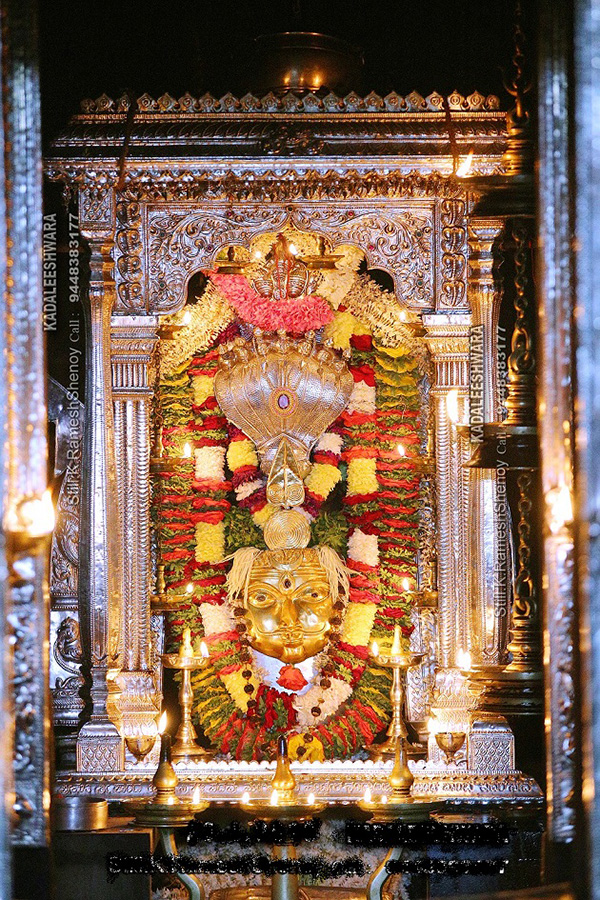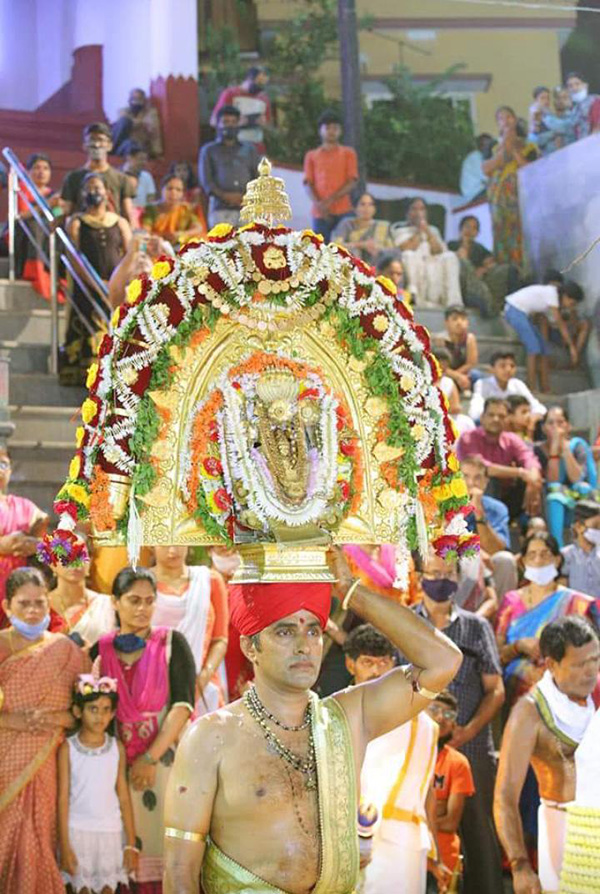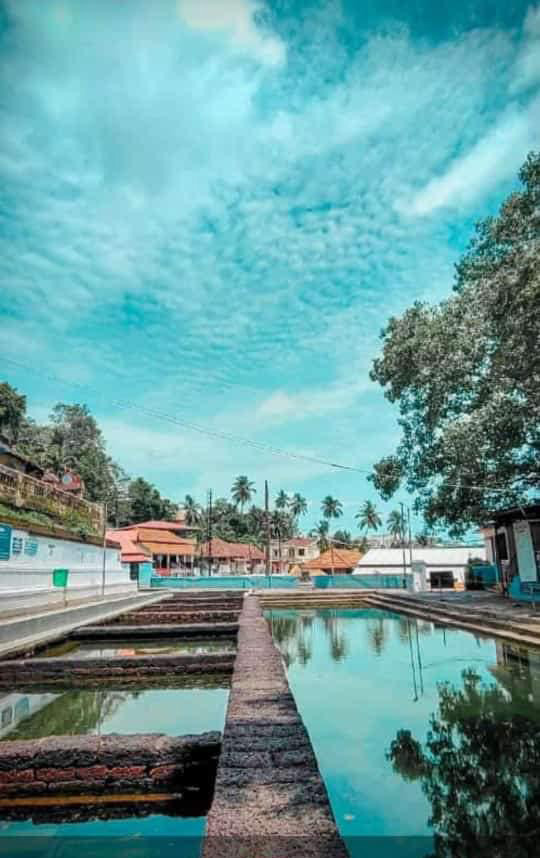The temple’s location is mentioned in the ancient and unique text called the Bharadvaja Samhita, which outlines its early history. In ancient times, the place where the temple stands was known as Suvarna Kadalivana. Due to its unparalleled purity, described as Sarvasiddhi Mahasthana, Sarva Saubhagyadayaka, and Sarvasantapaharaṇa, the place was highly renowned.
After Lord Parashurama donated everything to the Brahmins, he undertook intense and severe penance to win the favor of Parameshwara (the Supreme Lord). Pleased with his unparalleled devotion, Parameshwara said, “O Parashurama, I reside eternally in the Rasakupa (sacred well) in Suvarna Kadalivana. Go there and worship me.” However, at that time, Suvarna Kadalivana was located under the sea. Therefore, Parashurama reclaimed this land from the ocean and began worshiping the Rasakupa for a long period. Eventually, the Trinity (Brahma, Vishnu, and Maheshwara) manifested in the form of Shri Manjunatha through the convergence of their divine powers to fulfill Parashurama’s desire. The origin of Shri Manjunatha and the miraculous events that followed are described in the 9th chapter of the Bharadvaja Samhita. In this context, the Saptakoti Maha Mantras (seven crores of sacred hymns) transformed into seven holy tirthas (sacred places), and the Shiva Pushkarini (a sacred tank) became widely renowned. At the same time, the holy Bhagirathi Tirtha emerged from a crevice and appeared in the northeastern direction.


In the later chapters of the Sthala Purana, the birth and heroic deeds of great yogis like Matsyendranatha, Gorakshanatha, and Chouranginatha are described in detail. It is further said that Matsendranath, an avatar of Shiva, accompanied by a queen named “Mangala”, an avatar of Parvati, along with his beloved disciple Gorakshanath, came to Suvarna Kadalivana while returning from ‘Satirajya’ and was welcomed by other disciples there. Then Matsendranath decided to enshrine a Shivalinga in Suvarna Kadalivana, and asked his disciple to go to Kashi and bring the Shivlinga. However, due to time constraints, Gorakshanatha failed to bring the Linga from Kashi. This caused Matsyendranatha to perform intense penance, praying to Shiva, and as a result, a Swayambhu Linga (self-manifested Linga) miraculously appeared. This event created both wonder and joy among the assembled yogis. After the appearance of the Swayambhu Linga, Gorakhnath brought a Shiva lingam from Kashi as it was no longer needed and kept it in a nearby theertha. After a long time, the Lord Annappa took the Shivlinga to Dharamsthala where it was enshrined by the famous Vadiraja Swami of Udupi. So Kadri Kshetra became `Adi’ temple for Dharamsthala.
In the Upasamharada Adhyaya (the concluding chapter), Yati Bharadwaja visits the Suvarna Kadaleevana temple and worships Sri Manjunatha Swami. He praises the extraordinary virtues and spiritual power of the devotees who worship Lord Manjunatha, emphasizing their unparalleled qualities and strength.
Sri Temple is believed to have existed since the 10th century, making it approximately 1100 years old. There is a legend that Lord Parashurama, after performing the Kshatriya massacre, atoned for his sins by worshipping Lord Manjunatha in the Rasa Koopa (a sacred tank). The belief also exists that the saints of the Natha Parampara, born from this Rasa Koopa, had direct visions of Lord Manjunatha and performed worship there. The belief that the Pandavas built a temple at the Rasa Koopa during the Dwapara Yuga is widespread in local tradition and oral history. The original idol of Lord Manjunatha is believed to have manifested in the Rasa Koopa as a Shiva Linga, while other idols are believed to have been installed through human intervention. One such idol is Trilokeswara, which was installed by King Raja Kundavarma in 968 BCE, according to historical records. Devotees who come to God’s darshan, confess their difficulties and wishes to God, pray and find solution. It is subject to their discretion and faith in God. This temple is famous as Abhishek and Tirtha Kshetra. Many devotees who come here throughout the year take a bath in the holy theerthas of the temple, put the Kalash theertha and get darshan of God as a pious person, and are blessed. Also, the first day of the temple’s annual festival is celebrated as Kadri Tirtha. The temple hosts several important rituals, including Rudra Abhisheka, Ekadasha Rudra Pooja, Ranga Pooja, Tula Bhara, and Shata Rudra Abhisheka, all of which are regarded as special services for the devotees. The temple is located on the Kadri Hill, in the heart of the town, surrounded by natural beauty, including rocky boulders, hills, streams, ponds, and lush green gardens. This adds to the picturesque and serene atmosphere of the temple.


The temple also has a rich historical background, with two stone inscriptions at the entrance, which are believed to contain important references regarding the temple’s history. The temple’s architecture, including sculpted idols, stone walls, columns, and the exquisite art and sculpture work, points to its existence in the 10th century. The presence of Buddhist Stupas on the stone pillars of the temple suggests that earlier traditions, including Buddhist practices, might have been active in the temple complex. The services in the temple are dedicated to the belief and faith of the devotees. Many devotees, according to their wishes and convenience, offer services to the deity and pray for the resolution of their difficulties. After receiving relief or fulfillment, they return and perform the services they had promised. Some events that have yielded excellent results are prevalent in the local dialect and are passed down as stories. In the temple, the sacred water used for the deity’s abhisheka (ritual bathing) is offered to devotees daily in the form of Kalasha Snana (ceremonial bathing with a sacred vessel), allowing them to purify themselves and attain spiritual merit. People believe that if they take a bath in the Nava Kundas near the temple, they will get rid of skin diseases and get rid of their sins. Therefore, on the first auspicious day of the annual festival, thousands of devotees are being purified in this temple. This sacred place is considered a sacred pilgrimage site, and its holy waters are famously known as a powerful remedy for various sins and misfortunes. There are numerous instances and stories in the local tradition where people have found relief and resolution to their problems through the purifying waters of this sacred place.